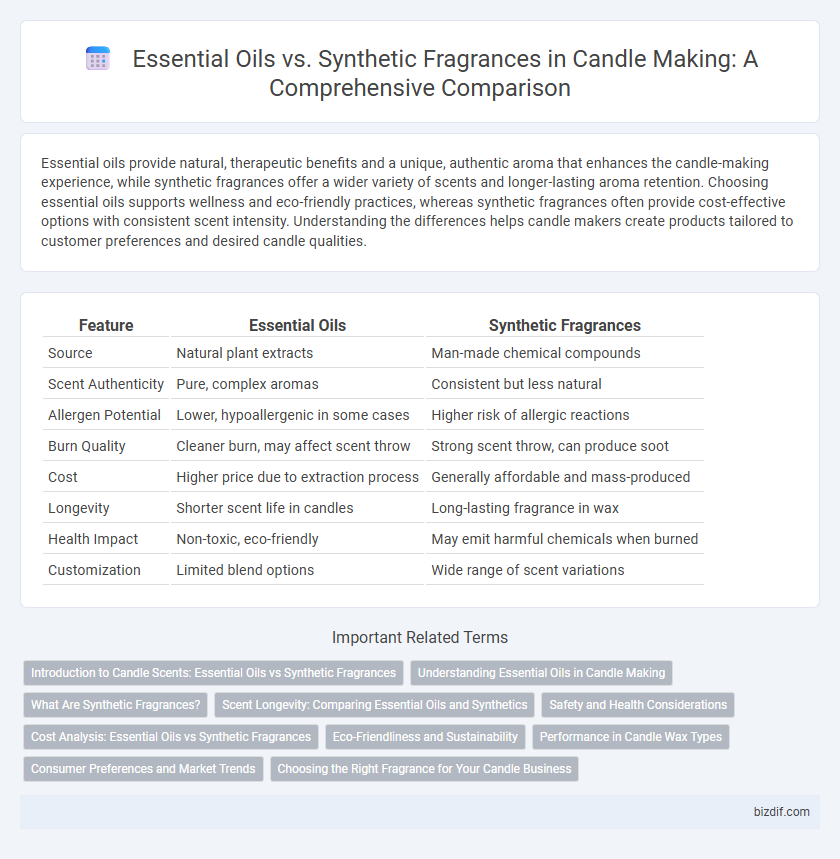Essential oils provide natural, therapeutic benefits and a unique, authentic aroma that enhances the candle-making experience, while synthetic fragrances offer a wider variety of scents and longer-lasting aroma retention. Choosing essential oils supports wellness and eco-friendly practices, whereas synthetic fragrances often provide cost-effective options with consistent scent intensity. Understanding the differences helps candle makers create products tailored to customer preferences and desired candle qualities.
Table of Comparison
| Feature | Essential Oils | Synthetic Fragrances |
|---|---|---|
| Source | Natural plant extracts | Man-made chemical compounds |
| Scent Authenticity | Pure, complex aromas | Consistent but less natural |
| Allergen Potential | Lower, hypoallergenic in some cases | Higher risk of allergic reactions |
| Burn Quality | Cleaner burn, may affect scent throw | Strong scent throw, can produce soot |
| Cost | Higher price due to extraction process | Generally affordable and mass-produced |
| Longevity | Shorter scent life in candles | Long-lasting fragrance in wax |
| Health Impact | Non-toxic, eco-friendly | May emit harmful chemicals when burned |
| Customization | Limited blend options | Wide range of scent variations |
Introduction to Candle Scents: Essential Oils vs Synthetic Fragrances
Essential oils in candle making offer natural aromas derived from plants, delivering authentic and therapeutic scent profiles that enhance ambiance and mood. Synthetic fragrances provide a broader spectrum of scents, often at a lower cost, with heightened longevity and intensity but may lack the purity of essential oils. Choosing between essential oils and synthetic fragrances depends on desired scent complexity, candle performance, and personal wellness preferences.
Understanding Essential Oils in Candle Making
Essential oils in candle making provide natural aroma derived from botanical sources, offering therapeutic benefits and authentic scent profiles. These oils contain complex chemical compounds that evaporate gently when heated, creating a subtle and evolving fragrance experience. Unlike synthetic fragrances, essential oils contribute to a cleaner burn and often enhance mood and well-being through aromatherapy effects.
What Are Synthetic Fragrances?
Synthetic fragrances are man-made aromatic compounds created through chemical processes to mimic natural scents or produce unique aromas not found in nature. These fragrances often consist of complex mixtures of chemicals, including phthalates or petrochemical derivatives, designed to provide consistent and long-lasting scent profiles in candles. Unlike essential oils derived from plants, synthetic fragrances offer a broader variety of scents at a lower cost but may lack the therapeutic properties associated with natural extracts.
Scent Longevity: Comparing Essential Oils and Synthetics
Essential oils tend to fade faster in candles due to their natural volatility and lower concentration of aromatic compounds, often lasting around 1-3 hours when burned. Synthetic fragrances are engineered for enhanced scent longevity, maintaining a consistent aroma for up to 6-8 hours or more during candle use. The choice between essential oils and synthetic fragrances significantly impacts the lasting power and throw of the candle's scent profile.
Safety and Health Considerations
Essential oils offer natural aroma profiles derived from plants, minimizing exposure to synthetic chemicals that may cause respiratory irritation or allergic reactions. Synthetic fragrances often contain phthalates and other harmful compounds that can emit volatile organic compounds (VOCs), posing potential health risks during candle burning. Choosing candles with pure essential oils supports safer indoor air quality and reduces long-term exposure to toxins.
Cost Analysis: Essential Oils vs Synthetic Fragrances
Essential oils generally incur higher costs due to natural extraction processes and limited raw material availability, while synthetic fragrances offer budget-friendly alternatives with consistent pricing and scalable production. The price of essential oils fluctuates based on botanical source rarity and harvest conditions, contrasting with the stable, mass-produced synthetic fragrances that reduce overall candle making expenses. Choosing between essential oils and synthetic fragrances hinges on balancing cost considerations against desired scent authenticity and candle market positioning.
Eco-Friendliness and Sustainability
Essential oils are derived from natural plant sources, making them biodegradable and less harmful to the environment compared to synthetic fragrances, which often contain petrochemicals and non-renewable resources. The sustainable harvesting of essential oils supports biodiversity and reduces chemical pollution, aligning with eco-friendly candle-making practices. Synthetic fragrances can emit volatile organic compounds (VOCs) that contribute to indoor air pollution, whereas essential oils generally provide a safer and more environmentally responsible scent option.
Performance in Candle Wax Types
Essential oils provide natural aroma profiles that perform best in soy and beeswax candles, enhancing clean and slow fragrance throw due to their volatile compounds. Synthetic fragrances offer stronger scent retention and more consistent diffusion, especially in paraffin wax, where their chemical stability withstands higher melt points. Selecting between essential oils and synthetic fragrances depends on the candle wax's composition and desired scent intensity and longevity.
Consumer Preferences and Market Trends
Consumers show a growing preference for essential oils over synthetic fragrances in candle making due to their natural origin and perceived health benefits, driving demand for eco-friendly and clean-label products. Market trends indicate a surge in artisanal candles featuring pure essential oils, catering to wellness-focused buyers seeking aromatic experiences free from harmful chemicals. This shift influences the candle industry to prioritize transparency and sustainability in fragrance sourcing to capture environmentally conscious and health-aware segments.
Choosing the Right Fragrance for Your Candle Business
Essential oils offer natural, complex aromas derived from plants, appealing to customers seeking eco-friendly and therapeutic benefits in their candles. Synthetic fragrances provide a wider variety of consistent and long-lasting scents, often at a lower cost, making them suitable for mass production and niche custom blends. Candle makers must balance scent authenticity, safety, and budget to select the ideal fragrance type that aligns with their brand values and target market preferences.
Essential oils vs Synthetic fragrances Infographic

 bizdif.com
bizdif.com